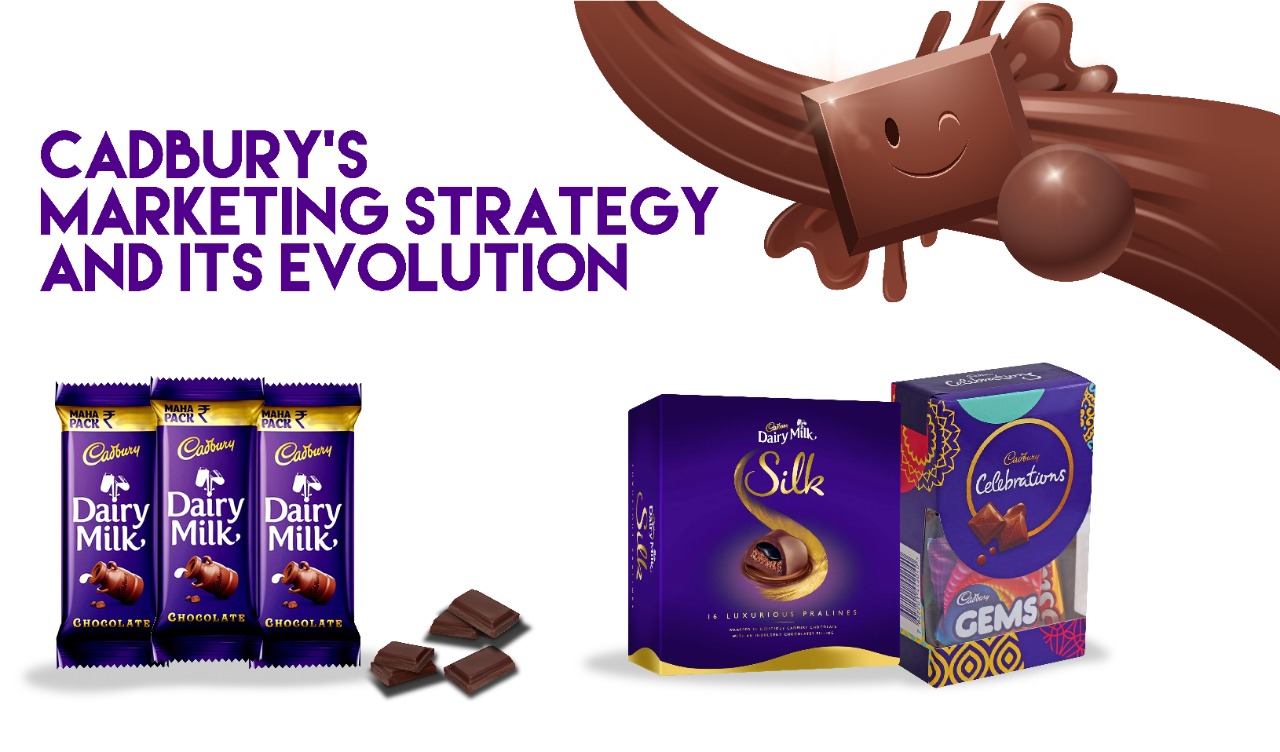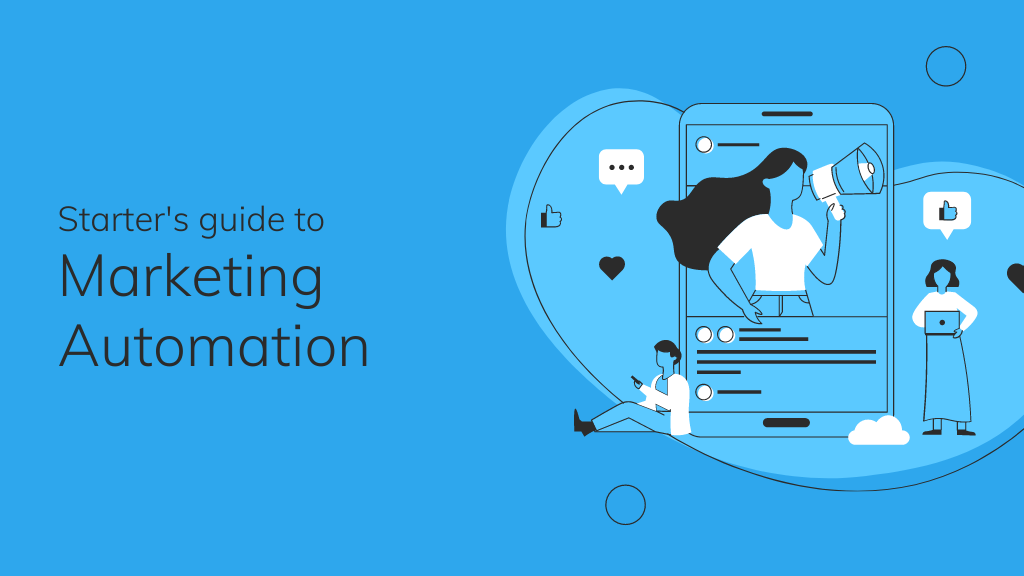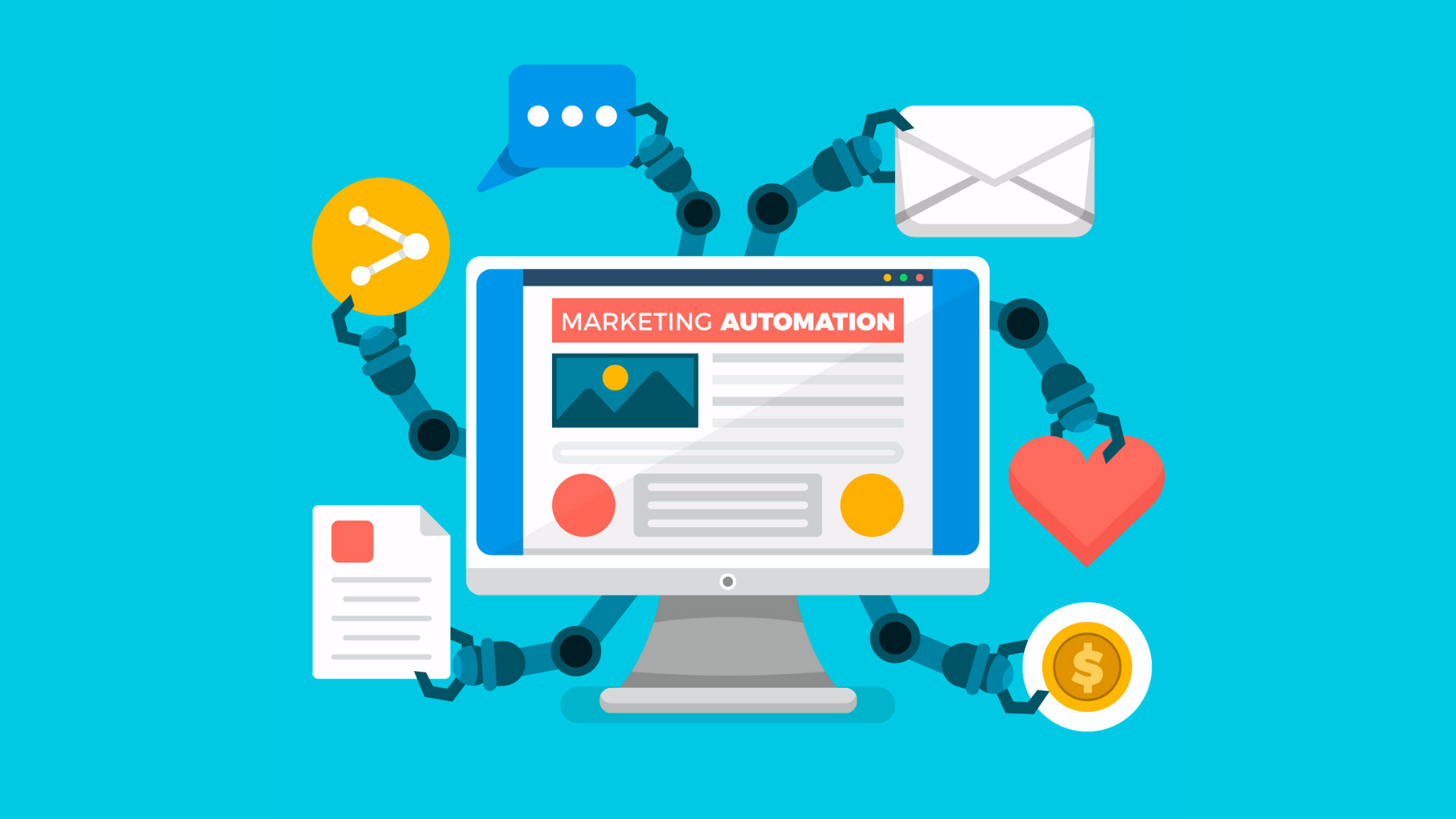Cadbury’s Marketing Strategy and Its Evolution
As a global community, we are all well aware of the importance of decadent sweets in our
celebrations or daily routine. Irrespective of the religion, culture, gender or nationality we belong to,
the one thing that brings us together is food. And desserts top the list when it comes to our idea of
sharing love. That being said, how often do you happen to think of digging into some chocolate and
the first thing to cross your mind is Cadbury’s?
Such is the influence of the brand on the consumers that most of them don’t even ask for a
chocolate when shopping, rather a Cadbury! Before digging deeper into how Cadbury became the
most accessible, and easily available, go-to dessert of our day-to-day lives, let take a look at how the
brand has evolved since its inception during the times of no digital channels.
Beginning of a brand legacy
Established by John Cadbury in the early 1800s in Birmingham, England, Cadbury’s journey in India
started in 1948 with Mumbai as it headquarters. Importing chocolates seemed like a new yet thriving
business then. With the rising demand and popularity amongst those who could afford luxury
chocolates in India back then, manufacturing operations soon started at multiple locations including
in India.
With the growing demand and love for chocolates in the coming decades, the first-of-its-kind
chocolate brand in India brought more and better variants for the chocolate apart from venturing
into beverages like Bournvita, for its consumers, only to fuel their love for chocolate.
From then to this day, Cadbury India has a share of over 70% in the market, making it a market leader
in the industry globally. But how did it establish its identity in the Indian market where sweets made
of milk, gram flour, sugar, or leftover churned cream, had been ruling for decades.
Understanding the culture, demography and purchasing power of the citizens and then devising
campaigns to grabbing the interest of the audience in India may have started with a hiccup, but
Cadbury for sure knew the way to the Indian hearts. Speaking of which, the channels of
communication to reach its consumers may have evolved over the time, but what hasn’t, are the
emotions. And the chocolate giant seems to have been consistent in its approach to portray the
emotions onscreen with one gimmick after the other, even in times of crisis management.
Taking a close look at how has, Cadbury retained its brand value consistently, decades after it was
introduced in the land of desi sweets.
- Identify the right audience
In the initial years of its arrival in India, chocolate was considered a luxury which was affordable
only to upper middle class and above. To expand its customer base and turning it into an
opportunity in the next few years, Cadbury launched a mini version of the chocolate, with the
price and contentment considerations that came along for buying a chocolate to the middle
class. The centre-filled chocolate taste of Eclairs had the widest reach possible through TV and
newspaper commercials when it entered the choice list of every 80s and 90s kid for their
birthday celebration in school, or as a token of good work from parents. Till this day, Cadbury
Eclairs, renamed Choclairs in 2013, has a strong hold in the semi-urban and rural market. - Increase the target market – Chocolate for ALL
Once popular with the kids, Eclairs and Dairy Milk had established itself as a symbol for inherent
goodness and friendship between kids. While the sales and revenue from these two had beenconstantly rising, the brand was perceived as a kids-ONLY. In 1994, Cadbury released a TV
Commercial with tagline ‘Kuch Khasa Hai…. Asli Swaad Zindagi Ka’ to break the brand’s kids-only
image and positioned it as a product for everyone’s consumption, irrespective of the age or
gender. What else could be a better combination than the girls and Cricket and it gave birth to an
advertisement, where a young female dancing on the cricket field while enjoying the taste of
chocolate.
Now, that’s an act every Indian desire to do that when Yuvraj Singh hits the last six to win the
World Cup in 2011. Isn’t it?
To think of it in the digital age, the video would have gone viral with memes reigning the social
media for the next couple of weeks. - Encashing Festive – “Gift” Promotional Campaigns
Once Dairy Milk had penetrated the Indian dessert industry, it began to leverage forward looking
attitudes and culture which were aspirational. From a girl running on a racetrack, to older people
eating chocolates and singing in the street, Cadbury ensured it touched every feeling in the society,
which also included a very essential aspect- gifting and festivals. Valentine’s day, for example, had
hardly seen any excitement among the youth of India. As a handy, go-to, happiness-inducing
element, dairy milk chocolate was used for the first time as a gift to someone special.
Aware of how, we as a nation, consider our festivals and celebrations incomplete without sweet,
Cadbury Celebrations was launched in the late 2000s that not only became the alternative to local
sweets but also increased the volume sales.. Be it representing a sweet-n-rocky brother-sister bond,
or a family function, the array of innovation around Cadbury Celebrations catered to every aspect of
gifting making it a symbol of happiness. The almond, cashews, and raisins enrobed in rich chocolate,
wrapped in a blingy purple box made Celebrations a convenient, go-to gifting choice for Indians who
consider dry fruits an auspicious element in food.
The portrayal of siblings fighting over chocolate in a Raksha Bandhan ad, or a parent celebrating with
something sweet on the daughter’s major achievement was relatable to the audience. Till date, these
ads continue to effectively drive sales through various digital platforms like YouTube through paid
campaigns and customer engagement through Influencer marketing.
Bottomline…. What picked up Cadburys sales…. Viral Advertisements on the Television media…
Most watched. - Crisis Management
In the 2000s, Cadbury saw a major backlash when few packets of Dairy Milk were found to be
ingested with worms. At that point, Cadbury was struck with the worst crisis ever with Dairy Milk
experiencing rejection from everywhere. It wouldn’t be incorrect to say that Cadbury began with
‘Influencer marketing’ much before digital channels overpowered the generation, when it roped in a
veteran Bollywood star with a huge fan following among parents in all parts of India.
Cadbury’s took the route of influencer Marketing and that’s how Amitabh Bachchan, as the first
celebrity was brought onboard as the brand ambassador to promote Dairy milk under the ‘Kuch
Meetha Ho jaaye’ series of ads. The move was necessary after the worm controversy that had a
huge negative impact on the sales and revenue in the following months. To go more aggressive with
positive branding, Cadbury increased its ad budget by 40%.
The same year to gain the customers trust back, Cadbury launched the Miss Palampur ad campaign
while they activated Project Vishwas. The commercial talked about a cow’s victory on winning the
title and her so-called father (played by AB) who proudly described how tough the competition was.
The campaign was set in villages to win the trust of rural India without losing its urban appeal.
Cadbury left no stone unturned to tell the story. They tapped every channel to ensure its reach was
as wide as possible– TV, print media, radio and hoardings, bus shelters, retail points, and of course
digital. Between 2005-09 the brand increased its sales to double, from 22% to 44%.
Coming to think of it as a 360° marketing firm, traditional marketing worked wonders when digital
transformation was a thing talked of as in the future. However, wouldn’t the brand tap every digital
channel in this age, from YouTube ads to paid campaigns on FB, trending hashtags on Twitter, or
video contests on IG reels and Influencer marketing- to communicate how they would be honored if
the audience gave them another chance? - Traditional and digital channels
The digital transformation era may have made it easier for brands to reach out and engage with their
consumers directly, but the emotions remain unchanged for decades. And that is what worked the
most for Cadbury.
A year back when we were hit with a pandemic, and numerous versions of lockdown had impacted
the economy, people from different strata of the society had a tough time juggling between their
lifestyles and health safety. 2020 turned out to be a year when the world needed a high dose of
generosity. This led to the brand launching a limited-edition CDM ‘Thank-you’ bars. To add to the
generosity here, the choc-giant committed a part of the sale from these bars towards the health
insurance policies of the daily wage earners. #SayThankYou was seen trending on social media
channels during the lockdown. A report from Business Insider said that the company sold around 15
million bars and sponsored health insurance for about 15,000 domestic workers after the
campaign.
Going by the conventional way, we believe the brand would have launched an ad to portray the
challenges of frontline workers during the pandemic and made the audience aware of how their
families have been supportive and are managing in their absence.
Conclusion:
Typically, it is believed that consuming something sweet is comforting and is a mood lifter. And this is
something Cadbury’s marketing has always portrayed. Cadbury has never failed to reflect the
emotions of its audience thereby convincing them that it can be consumed by anyone, anywhere.
The campaigns have been effective through ages and different media and have a consistent message
for ALL age groups- someone who is with you through the ups and downs of life, helping you bounce
back.
Managing and controlling the brand was a priority then and is a priority now. The medium has
changed, and channels of communication evolved. But what remains unaltered is the brand’s
capability to grab and project the emotions to build brand, increase sales and manage reputation
even under crisis situation. Thats the power of Marketing.
Starter’s guide to Marketing Automation
Like the rest of the world, the face of marketing is also changing, and it’s the digital way of things that is becoming the norm of the days to come. Although people often find the word ‘Automation’ confusing and repelling since the personal connotation attached to marketing campaigns begins getting blurred. But in reality, Automation is a handy tool in one’s kit, which makes the process smooth and helps in saving time and money.
Although marketing automation could be a way to deliver campaigns to an audience, other ways of connecting with the masses, such as commenting on customer reviews or rolling out video-based content, cannot be automated and hence require manual touch. In such situations, an Omni market suite comes in handy, which allows the marketer to look at all the channels of marketing pursued under a single branch.
Hence, this series of micro-blogs will helps us understand the importance of marketing automation and how to implement a basic automation suite using an Omnichannel marketing tool.
How Marketing Automation Tools can Empower Marketing Teams to Deliver More?
How Marketing Automation Tools can Empower Marketing Teams to Deliver More?
Today, what is the marketing automation buzz all about? Witness the great indicator here on how marketing automation is progressing rapidly in terms of technology by adopting with the human workflows. How big your team may be it from an engineer to an expert, people know what it means to do more tasks being allotted with fewer resources to do so and quite, it is harder for them to spend whole time carrying out their day-to-day operations much likely the “Marketing”. The best way to handle the situation is to step into the Marketing Automation.

Easy to connect to different data sources: Email marketing is an important touchpoint in the path to online purchase and hence businesses capture as many contacts as they can and these are sometimes enriched with more data so that they can make a more targeted campaign. Businesses use many sources for data storage and the most popular ones are the likes of AWS and Azure which are used by Campaigntocash in addition to internal servers. The email analytics dashboard that you are using should be able to connect to all types of data sources so that business can use the already collected data to good use in their campaign. This customizable dashboard can take data from disparate sources and store them in their internal server and use it to display useful data.
Select data range: The dashboard has another useful feature and that is selecting data range to get the analytics. There are many occasions where there is a need for data aggregation using multiple mailing reports. When you have such multiple reports you can then select based on a data range. For example, if you want to select all the emails that were sent within a date you can do so easily. Using this data many future marketing strategies can be adopted.
Focus on key email marketing metrics: One of the key challenges for marketers after they have built the mailing lists is to get them to opt-in for emails. After that is done, it is essential to not lose them and keep them engaged and interested in the email programs. To do that it is essential to understand the after-click behavior. The bounce rate and the time spent by the subscriber on the website will give an indication of whether the audience is interested or not. This dashboard gives KPI metrics like Click-Through-Rate, No of clicks, bounce rate, delivery rate and unsubscribe rate which gives a quick view of where the goals for the email marketing campaign is met. If it is not then you can easily use the data to turn things around. Campaigntocash dashboard provides these key metrics so that it can be used effectively.
Lists the top campaigns: The dashboard lists out all the top performing campaigns based on the goals you have defined and the KPI metrics set. For example, it can list the top performing campaigns based on the open rate. It is shown along with details like metrics on the email sent, email opened, email clicked, the email bounced or unsubscribed. This data can be leveraged to create better performing strategies.
Nurturing emails and drip campaign through automation: The automation of workflow helps in lead nurturing and drip campaigns. In order to make the user who visited your website a customer, there is a need to nurture using specific email strategies. By lead nurturing it helps to connect, engage and gain the trust of your prospects, doing this manually takes a lot of time and money and that is where automation workflow can help. It can send relevant emails to the right audience at the right time and that increases the chances of conversion. The Campaigntocash software helps create that work flow easily through creating process flows. All you need to do is set the filter and the process flow gets triggered and the email is sent.
Another advantage of creating automation is it can help in drip campaigns which are done through email marketing. The content is sent at the programmed time automatically to the target audience which is set through the filter in the tool.
Gives a snapshot of the future campaigns: This dashboard not only lists the current campaigns but also the upcoming campaigns that are due in the future date. Any learnings from the current campaign that needs to be implemented in an upcoming campaign can be easily incorporated using the edit option.
Opt-in and unsubscribed: The subscriber activity displayed on the dashboard gives a clear picture of the audience and the health of the subscriber base. Further analyzing the dashboard you can then find out the most active subscribers and how they are engaging with the content. That will then help to develop a more effective and better revenue generating email marketing strategy.
Helps to determine the bounce rate: Finding the bounce rate is essential for email marketing as it indicates the number of emails that could not be sent to prospective customers due to errors. The Campaigntocash analytics dashboard shows the bounce rate in an email campaign. It is intelligent to differentiate Bounce emails into permanent (invalid or non-existent email address) or transient (server issues, mailbox full, etc) along with other details like the sub-bounce type. This information helps to get more relevant data and also resend emails at a later time for temporary issues.
Put Email Stats on the chart: As part of digital market strategy many traffic sources will be implemented and email will be one of them. In order to compare how it performs with the other channels having a dashboard dedicated for email, tracking is essential and that is what this tool offers. It also helps to determine how the email is performing in the KPI’s to accomplish the goals.
Get demographic information: The email analytics dashboard gives a great deal of information about your website visitors. It can capture data like the location, age, gender, number of visits, etc using which you can make a better-targeted approach and offer content that can make acquisitions.
The Campaigntocash email analytics dashboard will help you get the most of the data that you have integrating it with real-time data. The data like the opens and clicks helps you understand how customers are engaging in your content and to provide a better deal to them and thereby generate more revenue for your business.
5 Don’ts to Follow While Drafting Multichannel Marketing Strategy
5 Don’ts to Follow While Drafting Multichannel Marketing Strategy
Consumers today are bombarded with numerous marketing messages every day. For marketers, it has become essential to create a campaign that can make an impact cutting through all the clutter. One of the ways of doing it is through multi-channel marketing by using many channels like email marketing, print, banner ads, etc. But this technique can only work if the best practices are followed and also ensuring that some costly mistakes are not made by marketers. Here is a list of don’ts to follow while using multichannel marketing.
- Don’t send a lot of emails: Email marketing through best email marketing tools is an effective way to communicate about your brand to the customers. But sending a lot of emails is not the only way to promote your brand. Use of other channels like Social Media as a way to generate more leads and more ROI.
- Don’t spam: The myth surrounding multi-channel marketing is that using multiple channels is equal to spamming. Don’t send the same message in all channels as that can be marked as spam by users. Use different design, color, Call-To-Action, fonts, etc. across various channels yet keeping the core message intact.
- Don’t forget mobile: The amount of time consumers spend on their smart phones is increasing. Often the content that is sent by many brands is not optimized for mobile which can quickly turn to become a costly mistake. With consumers spending a lot of time on mobile, the content should be designed for optimal mobile viewing and also to give a great user experience.
- Don’t give a crap- work on content: Not curating informative content is one of the biggest mistakes. A one-fit-solution does not work especially in multi-channel marketing. A copy-paste of another campaign without curating informative content but just replicating others’ content and design is not the right approach and can become easily noticeable by the users.
- Don’t focus on the channel but on the consumer: Most companies make the mistake of not focusing on the consumer. Instead, they try various ways to build their presence through black hat SEO or choose other ineffective channels. Instead, they should focus on channels that their customers are on and deliver personalized content that will generate leads. Spend enough time researching what customers need and how to reach them rather than sticking to a channel.
There is an abundance of choices and channels for a customer and hence just delivering the message is no longer enough. These messages have to be tailor-made for the audience based on the preferences, demographics, channel preferences, current location and much more. When the customers are engaged this way they are more willing to receive and act irrespective of the channel.
The role of a campaign manager who manages multi channel campaign management is highly critical as they provide highly choreographed campaigns across multiple channels such as emails, social, sms, push campaigns so that the customers find the messages trustworthy and useful. We recommend campaigntocash for acquiring the results and also to get insights and reports that can be used to make better decisions. That way business can communicate better with customers and also understand the challenges and tailor the strategies accordingly.
10 Reasons Why Marketers Should Be Using Campaigntocash QR code Analytics Dashboard Today
10 Reasons Why Marketers Should Be Using Campaigntocash QR code Analytics Dashboard Today
The Quick Response code or the QR codes are two-dimensional barcodes which are square in shape and store information that can be read by an optical label reading machine. The QR code contains information which ranges from a website, phone number, email address to a simple text. It looks like a series of patterns of black dots and white squares arranged in a square grid. These patterns are scanned by an imaging device like a scanner or a smartphone camera and translated into human-readable form.
There are mainly two types of QR codes available in the market, the static and the dynamic codes. In a static QR code, the information stored is fixed and the data is stored directly in the QR graphic whereas in a dynamic code a small URL is placed in the QR code which then directs the user to the destination. The destination can be changed as many times as you want and can also be used to create a dashboard for analysis of QR codes using an application like Campaigntocash.

Reasons to use QR code Analytics Dashboard
Using dynamic QR Code changes are easy to make: Once the marketing material is printed and distributed there is no way to go back and undo changes. But not when you use dynamic QR codes the content can be updated and one can quickly respond to changes in the project even if the material is in the hands of the customer. For example, if you are in the process of building a new website and it is still not ready, you can still print the advertisement material and send it if you use a dynamic QR code as you can change the URL of the website when it is ready.
Download the analysis: Using a QR Code management tool with analytics dashboard is useful as it gives you deeper insight into the way the marketing campaign is working and thereby provides an opportunity to improve the conversion rate. For example, you have created a marketing campaign and want to see the number of scans by users per day. The QR analytics dashboard provides this data. You can download and view data regarding how many people scanned the QR code, the location of the user and other details like the scanning device, etc.
Export/Import QR code scans: The dashboard not only allows you to view the scanned QR code data but also to export or import the contents into and from various files formats so that it can be used for further analysis by various teams. For example, the scanner QR codes can be exported into a .csv file and then further investigated by creating filters.
Creating QR codes: Creating a dynamic two-dimensional barcode which can be ready by various devices like the mobile, tablet or desktop is pretty simple while using a code generator like that of Campaigntocash. All one has to do is enter the data that has to be embedded and the code gets generated right away. For example to create a QR code for your email campaign. Enter the email id, subject, and message. Click on the create QR code button in the application and see the code get generated immediately.

Create bulk QR codes: The code generator not only helps to create a single QR code but has the capacity to create multiple QR codes at once. For example, a company is running a successful campaign and selling products rapidly it wants to create bulk QR codes to track inventory and to downgrade or upgrade the inventory based on the QR code analytics it can do so by using the create bulk QR code option.
Create landing pages: When you are running a QR code marketing campaign it is essential to have an optimized landing page which can link it to the URL on the QR code. One of the ways to make a user-friendly landing page is through the use of QR management tool which provides templates to create a fully responsive page.
Download QR codes: Using the QR management tool, the QR codes can not only be created but also downloaded into various file formats. For example, if your company is looking to integrate the code with marketing materials and also want to print it in large size as a billboard it can be done so by downloading the QR code.
Coupon QR codes: QR codes can be linked to a coupon to market the campaign effectively using this tool. That can help you get more customers to scan and signup or subscribe. For example, a coupon for a 15% discount on the bill in exchange for an email signup or SMS subscription for a restaurant can be added with the QR code.
Adding QR codes to other applications: One can use various QR codes to run campaigns in many applications using the QR management tool. For example: Run a Social Media QR code and link it to all your social media pages and let your user choose the platform to connect or follow.
Analyzing the results: The QR code generator helps to measure each code scan which has been distributed. It not only measures the unique scans made by the users but also tracks which device was used to scan be it desktop, mobile or tablet. The graphical and statistical representation helps you to analyze and measure the results as you have all the data present on the dashboard.
QR code plays an important role in digital marketing as it is a bridge that connects the online with the offline world. QR codes allow brochures, adds, poster, etc to direct the users to the landing pages which contain all of the information that cannot be added on a printed page. It integrates the mobile, print and the web and adds value to the overall marketing effort.
Marketing Automation Workflows and Lead Nurturing Triggers every marketer should know
Marketing Automation Workflows and Lead Nurturing Triggers every marketer should know
Today, it is possible for a business to reach everyone right from generating new leads to current customers with the relevant messages customized to match their individual needs. Ever, marketers are in search of more efficient processes in their daily and for them, “Workflow” is an ex excellent way to simplify and streamline their internal processes. While interacting with the brand, marketing automation allows them to react quickly to the actions that their diverse audience generates thereby assisting them in gaining more sales that are the qualified leads, shortening their sales cycles, making it more efficient, improving customer engagement, driving conversion and sales, and best of all the others is to measure their efforts.
Here, in this help section, we’d help you know how marketing automation workflows can help you move customers from leads to loyalists. This section would help you learn how to match common triggers, specific actions taken by your audience with an automated response that would nurture prospects and retain customers for the long term.
What Marketing Automation Workflow is?
Marketing automation workflow is a set of automated actions that are being set up to respond to some of the external events and customer behaviors. Workflows go way beyond simple marketing automation. In general, companies functioning with the strong automation processes may have the automation workflows for the new customers, new subscribers, new qualified leads, and etc. Indeed, successful automation workflow requires the clear and of course measurable goals of engaging more customers and more cross-selling and up-selling.
Common Marketing Automation Workflows: Every marketer must know..!
Marketing Automation Workflows are indeed the mechanisms that are used as a trigger which can be said simply as the customer actions that launches the marketing automation processes. For example, when a customer performs an action like subscribing to a newsletter or signing for a demo, they will be directed to the relevant workflows that have been already programmed into the system. Some of the common marketing automation workflows are listed below:
- Turning prospects into leads
- Turning leads into customers
- Turning customers into highly engaged customers
Lead Nurturing needs Workflows, a must: Uncover the top reasons here!
In the modern world of marketers today, Workflows are considered to be one of the most powerful tools. At present market world, workflows are considered to be the easier and more effective tool for lead management and discover the reasons below that why workflows are to be used.
- Using Workflows convert leads into customersGone are the days where one big mail has been sent to all of your leads and staying relevantly with the hope that it’s enough for some to click and get engage with it. Now, the time has changed and it’s wise to start using smarter tools that send your leads what they are exactly looking for. According to a recent report, 60% of survey respondents using marketing automation have got the increased leads that get passed to sales. Simultaneously, the time would be saved by 23% more.
- Workflows help customizing contents and timingsIf you are having a handful of leads that are much closer to the one being ready to buy, there a workflow can be set up where three emails will be sent to them in a week instead of sending an email in a week. This is how the workflows can be set just to trigger the leads like that of small businesses who can respond back only on weekends as Saturdays and Sundays may be in the morning time.
- Implementing workflows saves time greatlyThe first priority the marketers would be giving upon is their time and using the workflows, the time strategy can be analyzed and saved flexibly where they can choose their time as they need and simply put them in the tool and not in their calendar.
Workflows take marketing automation to the next level: How?
A crucial part to make every marketing strategy more effective is ultimately the “Lead Nurturing” and yes; lead nurturing is a must to manage leads properly. If the leads are managed properly, definitely the time, money, and marketing resources will be saved. Being one of the powerful tools available for the marketers today, Workflows are an efficient way to take lead nurturing to the next level and it helps marketers to build stronger relationships with their leads, to send higher level leads to their team by saving their time as a marketer.
Start using automated Workflows: Know when the right time is!
Indeed, an automated workflow is essentially a virtual assembly lime that streamlines the work you do by maximizing the efficiency and minimizing the errors. Companies, with a solid workflow automation technique, can cut down their costs by creating automatic and step-by-step actions for all the internal processes. Want to make marketing more effective and save time? Now, it’s time to use Workflows.
When you have the question for the right time of using, definitely there is no explicit answer for this and it’s really up to people when they want to start integrating workflows into their marketing strategy. But, there are some indications which can be predicted about getting started with the marketing workflows.
Time to use workflows: “INDICATIONS” are here!
- When you are not targeted towards your offers and messages based upon the lead’s need
- When you are generating leads but ignoring people who’re not interested to buy
- While sending the same emails repeatedly to your list
- When your sales team is unsatisfied with the leads you are sending them
- While collecting all the valuable information and not using it for segmentation
- When you are sending and following the emails manually
- While updating the mass information of the contacts manually
- Really when you want to convert leads into customers with lead nurturing
Then, for what you are waiting for? On finding the right time, start using the workflows that end up efficiently.
Tips to trigger an automated workflow
Once the repetitive, or error-prone, or the inefficient tasks are identified, the following tips can be considered to trigger automation. It can be triggered:
- After a website visit depending upon your website goals
- After content post-download
- After a phone call to determine how someone discovered your company
- After a tour which is the personal way to get connected with leads
- After making the change in the sales stage and probability
Find out the must-to-have Marketing Automation Workflows here!
In the context of marketing automation, the workflows play a significant role which can be used to the framework of a customer journey with their touch points and where exactly the automated interactions came in. When it comes about the must-to-have automation workflows, there are neither ifs nor buts, as there are some workflows that every B2B marketing team must implement to match with the conversion rates. Amongst all, some of the workflows are internal and others are customer faced to ensure sales and marketing alignment.
Some of the must-have marketing automation workflows are listed below:
- Hot (Marketing-Qualified) Lead Workflow – (Trigger: Details of the lead scores)
- Welcome workflow (Trigger: user sign-up on the app or website)
- Cold Lead / Re-Engagement Workflow (Trigger: Identifies inactive contacts within the specified time)
- Lead Nurturing Workflow (Trigger: contacts and website form fills)
- New Subscriber Workflow (Trigger: New subscriptions to newsletters)
- Renewal/Upcoming purchase workflow (Trigger: Important dates)
- Event Workflow (Trigger: Registration for / attendance of your live event)
- Topic-Based Workflow (Trigger: Downloads of gated assets and views of similar pages)
- Feedback workflow (Trigger: Customer interactions with the support team)
- Closed-Lost Reason Workflow (Trigger: Indicates lost opportunities)
- Stuck-in-Sales-Funnel Workflow (Trigger: Opportunity inactivity after a specified stage in the sales funnel)
- Cart abandonment workflow (Trigger: Potential customers leaving the website)
- Anonymous user workflow (Trigger: Time spent on the website)
- Upsell workflow (Trigger: personalized sales in reference to the history)






